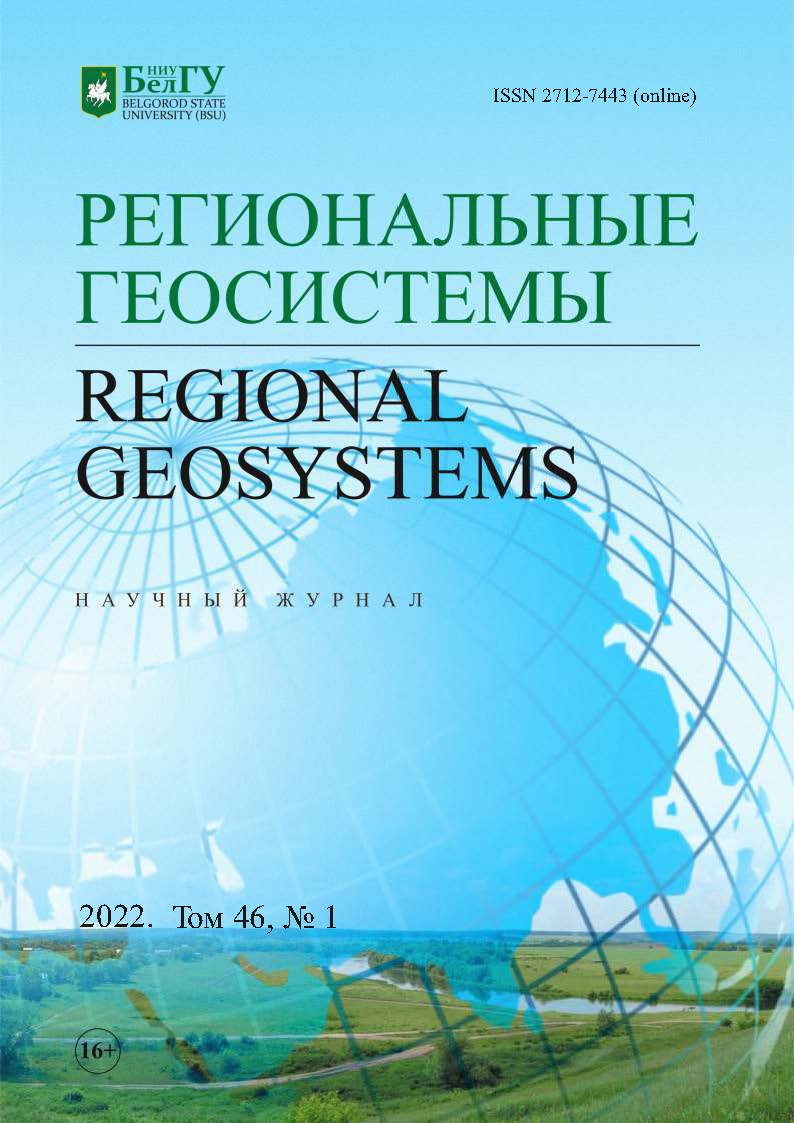Geoecological model for predicting degradation and restoration of the relief of military landfills
DOI:
https://doi.org/10.52575/2712-7443-2022-46-1-119-131Keywords:
terrain degradation, military ranges, aviation ranges, sustainability of ecological systems, entropy approach, Ferhulst modelAbstract
Military activity causes enormous damage to the environment both in peacetime and in wartime. Unlike chemical and physical pollution of environmental objects as a result of exercises, combat operations, and testing of new weapons, the impact of military activity on changing the landscapes of quite extensive and diverse territories has not been sufficiently investigated. The purpose of this work is to build a geoecological entropy model for assessing and predicting the level of environmental degradation of the relief of the territories of aviation polygons (using the example of the «Pogonovo» landfill, Voronezh). On the basis of the universal entropy model, a methodology for assessing and predicting the degradation and restoration of the relief of military ranges has been developed. The paper shows that the laws of distribution of ecological quantities are not purely random, but quasi-deterministic, therefore, additive addition of entropies of various subsystems is possible only in the case of identical laws of their distribution. With the help of the developed methodology, an assessment of the development of the ecological situation at the «Pogonovo» landfill was carried out. It is established that the ecological system located on the border of the norm-risk ranks is restored to an absolutely stable level of 0.995 for 30 years after the cessation of anthropogenic impact. With the intensification of the landfill activity to the level of average risk, the level of stability will decrease to 0,62 in 10 years. The upper limit of the stability of the geoecological system is observed when the area of the funnels is equal to half the area of the landfill; this state is equilibrium when anthropogenic impact ceases. If the system is in the area of a compensable crisis, then when the landfill activity ceases, the system spontaneously returns to the rank of environmental risk after 100 years, then remains in an equilibrium state. When a chaotic state of the system (bifurcation) occurs, the formation of a gully-beam relief occurs, then the forecast of development and self-healing of the system is impossible.
Downloads
References
Базарский О.В., Кочетова Ж.Ю. 2021. Энтропия абиотических геосфер и модель для оценки и прогноза их состояния. Биосфера, 13 (1–2): 9–14. DOI: 10.24855/biosfera.v13i1.572.
Геологическое пространство как экологический ресурс и его трансформация под влиянием техногенеза. 2014. Под ред. В.Т. Трофимова. М., Академическая наука–Геомаркетинг, 566 с.
Глушков Б.В. 2011. Геология отложений ледникового комплекса Донского ледникового языка. Вестник Воронежского Государственного Университета. Серия: Геология, 2: 40–48.
Забураева Х.Ш. 2012. Геоэкологические проблемы землепользования в Чеченской республике. Вестник КрасГАУ, 5 (68): 196–200.
Зонн С.В., Зонн И.С. 2002. Экологические последствия военных операций в Чечне. Энергия: экономика, техника, экология, 6–7: 50–53.
Иоффе А.И. 2013. Метод оценки неоднородности рельефа выделенной области. Исследование Земли из космоса, 3: 91–94. DOI: 10.7868/S0205961413020048.
Кочетова Ж.Ю., Базарский О.В., Бакланов И.О., Маслова Н.В. 2020. Влияние загрязнения почв объектов авиационной и космической деятельности на здоровье человека. Экология промышленного производства, 4 (112): 39–44.
Кочетова Ж.Ю., Маслова Н.В., Базарский О.В. 2022. Авиационно-ракетные кластеры и окружающая среда. М., ИНФРА-М, 266 с. DOI: 10.12737/1544137.
Компьютеры и нелинейные явления: Информатика и современное естествознание. 1988. Под ред. А.А. Самарского. М., Наука, 192 с.
Крюченко Н.О., Жовинский Э.Я., Панаит Э.В., Андриевская Е.А. 2015. Цинк и ртуть в почвах и растениях техногенно загрязненных территорий (на примере Яворовского военного полигона и территории завода «Радикал»). SCIENCERISE, 7 (1): 18–23. DOI: 10.15587/2313-8416.2015.47226.
Кудельский А.В., Стародубова А.П., Феденя В.М., Бурак В.М. 1997. Экология территории бывших военных баз. Литосфера, 7: 153–166.
Трофимов В.Т., Харькина М.А., Жигалин А.Д., Барабошкина Т.А. 2019. Техногенная трансформация экологических функций абиотических сфер Земли под влиянием военной деятельности. Вестник Московского университета. Серия 4: Геология, 1: 3–13.
Масленников А.А., Демидова С.А. 2018. Экспериментальная оценка токсического влияния тротила на микрофлору почвы. Токсикологический вестник, 6 (153): 34–38. DOI: 10.36946/0869-7922-2018-6-34-38.
Сафронич И.Н., Колесникова С.И. 2011. Сейсмический эффект взрывов на полигоне «Погоново». В кн.: Современные методы обработки интерпретации сейсмологических данных. Материалы Шестой Международной сейсмологической школы, 15–19 августа 2011, Апатиты, Федеральный исследовательский центр «Единая геофизическая служба Российской академии наук»: 303–307.
Смурыгин А.В., Бакин Э.Н., Асеев В.А. 2019. Особенности экологического обеспечения в Вооруженных Силах Российской Федерации. Пожарная безопасность: проблемы и перспективы, 1 (10): 393–395.
Харькина М.А. 2004. Экологические последствия военных действий. Энергия: экономика, техника, экология, 7: 56–59.
Хусаинова Р.З., Чуйков Ю.С. 2013. Проблемы экологической безопасности и безопасности персонала и населения при утилизации непригодных к использованию боеприпасов. Обзор. Астраханский вестник экологического образования, 2 (24): 156–169.
Douglas T.A., Walsh M.E., McGrath K.J., Weiss K.A., Jaramillo A.M., Trainor T.P. 2010. Desorption of nitramine residues and nitroaromatic explosives from soils detonated under controlled conditions. Environmental Toxicology and Chemistry, 30 (2): 345–353. DOI: 10.1002/etc.383.
Jenkins T.F., Hewitt A.D., Grant C.L., Thiboutot S., Ampleman G., Walsh M.E., Ranney T.A., Ramsey Ch.A., Palazzo A.J., Pennington J.C. 2006. Identity and distribution of residues of energetic compounds at army live-fire training ranges. Chemosphere, 63 (8): 1280–1290. DOI: 10.1016/j.chemosphere.2005.09.066.
Pennington J.C., Brannon J.M. 2002. The Ecological Fate of explosives. Thermochimica Actа, 384 (1–2): 163–172. DOI: 10.1016/S0040-6031(01)00801-2.
Mathematics Differential and Integral Equations, Dynamical Systems and Control Theory, Mathematical Physics. Series: Cambridge Texts in Applied Mathematics. 1994. Cambridge University Press, 240 р. DOI: 10.1017/CBO9780511626296.
Abstract views: 214
Share
Published
How to Cite
Issue
Section
Copyright (c) 2022 REGIONAL GEOSYSTEMS

This work is licensed under a Creative Commons Attribution 4.0 International License.


